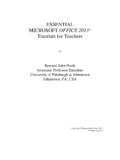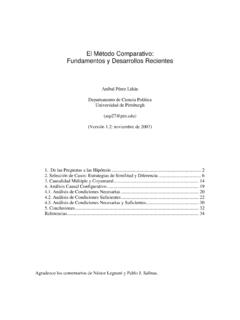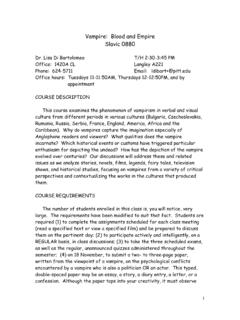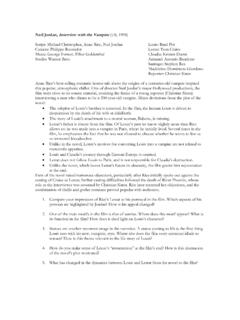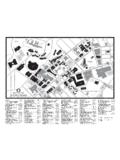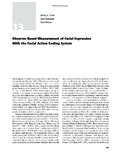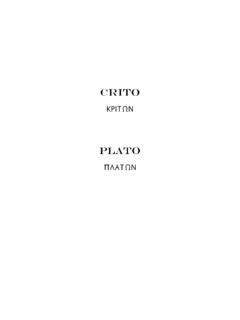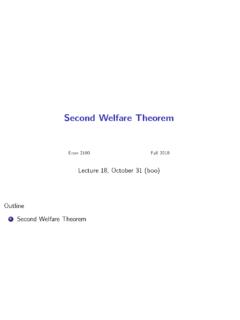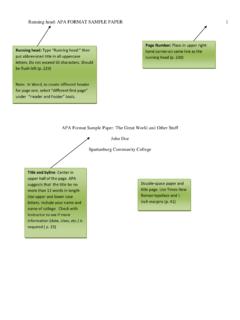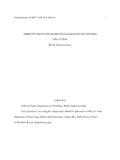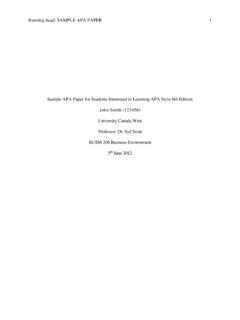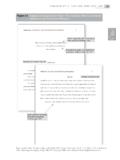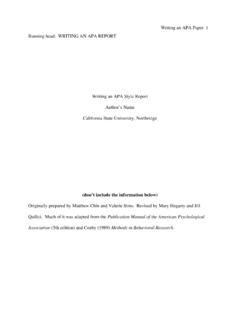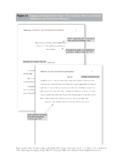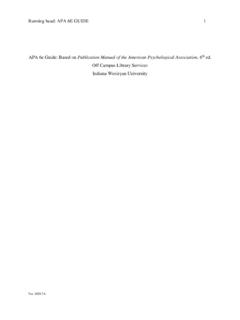Transcription of Sample APA Paper for Students Interested in Learning APA ...
1 running head: Sample FOR Students 1 Sample APA Paper for Students Interested in Learning APA Style 6th Edition Jeffrey H. Kahn Illinois State University Author Note Jeffrey H. Kahn, Department of Psychology, Illinois State University. Correspondence concerning this Sample Paper should be addressed to Jeffrey H. Kahn, Department of Psychology, Illinois State University, Campus Box 4620, Normal, Illinois 6179-4620. Email: Sample FOR Students 2 Abstract The abstract should be a single paragraph in block format (without paragraph indentation), and the appropriate length depends on the journal to which you are submitting, but they are typically between 150 and 200 words.
2 Section of the American Psychological Manual has additional information about the abstract. The abstract is important because many journal readers first read the abstract to determine if the entire article is worth reading. The abstract should briefly describe all four parts of an empirical Paper ( , Introduction, Method, Results, and Discussion). Consider writing one or two sentences summarizing each part of a Paper , and you ll have a nice abstract. Sample FOR Students 3 Sample APA Paper for Students Interested in Learning APA Style Before getting started you will notice some things about this Paper . First, everything is double-spaced. Second, margins are 1-inch wide on all sides.
3 Third, there are several headings used throughout to separate different parts of the Paper ; some of the headings are in bold. Fourth, there is exactly one space after each punctuation mark. Fifth, the upper left of each page has a running head in capital letters, and the upper right has the page number. This first part of the Paper is called the Introduction section or Literature Review , yet it does not have a heading that actually says Introduction . Instead, the title of the Paper is typed at the top of the first page (centered, but do not put it in bold). The importance of the topic should be pretty clear from the first paragraph or two of the Introduction. Section of the APA manual (APA, 2010) will help give you some ideas about how to write this. The bulk of the Introduction section is background literature on the topic, often helpful to provide a theoretical or empirical basis for your research.
4 Remember to cite your sources often in the Introduction and throughout the manuscript. Articles and books are cited the same way in the text, yet they appear different on the References page. For, example, an article by Cronbach and Meel (1955) and a book by Bandura (1986) are written with the author s name and the year of publication in parentheses. However, if you look on the References page they look a little different. Remember that APA style does not use footnotes or anything else for citations. Two other things about citations are important. When a citation is written inside parentheses ( , Cronbach & Meehl, 1959), an ampersand is used between authors names instead of the word and. Second, when citing an author s work using quotations, be sure to include a page number.
5 For example, Rogers (1961) once wrote that "the core of man's nature is essentially positive" Sample FOR Students 4 ( ) Notice that the page number is included here. Unless a direct quote is taken from a source, the page number is not included. The last section of the Introduction states the purpose of the research. Hypotheses are also included here. State your hypotheses as a prediction ( , I predicted ), and try to avoid using passive tense ( , It was predicted ). You will notice that hypotheses are written in past tense because you are describing a study you have finished. Method The Method section is the second of four main parts of an empirical Paper (see Section of the APA [2010] manual).
6 Papers that are reviews of literature would not have a Method section. There are typically three or four major subsection in the Method although there can be more. These subsection are separated by headings described in sections and of the APA manual (APA, 2010). Participants This brief section describes the people who participated in your study. (They should be called participants not subjects .) Mention the number of participants, the percentage of women and men, the mean age (where mean is abbreviated M), variability, and their ethnicity or cultural background. Any other demographic information describing your Sample would be appropriate here. Materials This section describes the tests, surveys, or instruments used to collect data. For example, if you used the Marlowe-Crowne Social Desirability Scale in your research, you might say that the Marlowe-Crowne Social Desirability Scale (MCSD; Crowne & Marlowe, 1960) comprises 33 true-false items that measure social desirability.
7 You would also provide the reader with Sample FOR Students 5 information regarding the MCSD scale s reliability and validity. Do this for each and every measure used in the study. If the purpose of your Paper is to develop a new questionnaire, you may wish to describe reliability and validity in the Results section (see below). Procedure This section describes in great detail the data-collecting procedures. Describe things like participants recruited, whether they participated alone or in groups, how informed consent or assent was obtained, what they were asked to do or how they were compensated for their participation. You should describe the procedure in enough detail that another researcher could conduct the same study ( , replicate it) just by reading about the procedure.
8 Results This is the section where the results of the data analyses are presented. Section in the APA manual (APA, 2010) will help a little bit. It s often helpful to use tables (see Table) to help describe your results, especially when you have a lot of data to report. You may find it helpful to remind the reader of the hypothesis before presenting each result. It is also a good idea to tell the reader what type of data analysis was done ( , correlation, ANOVA) before it is presented. State what alpha level you adopted; an alpha level of .05 is the standard. You don t interpret or explain your results here. It is appropriate to state whether or not your hypotheses were supported, just don t try to explain them that s why you have the Discussion section. Discussion The Discussion is the fourth and final section of the Paper .
9 This is the part where you interpret and explain your results. Try to explain why you found what you did in your study. Is it what you predicted? If not, why? Also, how do your findings fit in with information in your Sample FOR Students 6 Introduction? Are your results consistent or inconsistent with what has been found in the past? If they are inconsistent, how can you explain this? The explanation and interpretation of results will probably be the biggest part of the Discussion. There are at least two additional parts of the discussion. First, include limitations of the study. Describe the ways in which the internal or external validity of the study may have been compromised.
10 Future research ideas are often discussed when limitations are discussed. Second, describe the implications of your findings to theory or practice. Answer the question, How does my study add to psychological theory? In addition, think about practical applications of your findings. Perhaps give some additional directions for future research. Sample FOR Students 7 References American Psychological Association. (2010). Publication manual of the American Psychological Association (6th ed.). Washington, DC: Author. Bandura, A. (1986). Social foundations of thought and action: A social cognitive theory.

